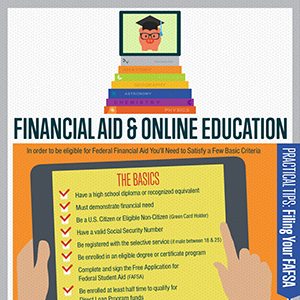Financial Aid and Online Education
In order to be eligible for Federal Financial Aid you’ll need to satisfy a few basic criteria.
The Basics:
Have a high school diploma or recognized equivalent
Must demonstrate financial need
Be a U.S. Citizen or Eligible Non-Citizen (Green Card Holder)
Have a valid Social Security Number
Be registered with the selective service (if male between 18 and 25)
Be enrolled in an eligible degree or certificate program
Complete and sign the Free Application for Federal Student Aid (FAFSA)
Be enrolled at least half time to qualify for Direct Loan Program funds
Did you know: Not long ago Congress required schools conduct more than 50% of their teaching in classroom settings to qualify as federal financial aid distributors. This requirement was lifted in 2006, allowing online colleges to disburse federal financial aid.
In order to be eligible for Federal Financial Aid, make sure the schools you’re looking at are accredited.
Primary accreditation bodies:
Six primary regional agencies
A number of national agencies
And scores of programmatic agencies
All of which must be endorsed by the Department of Education
For most purposes accredited online colleges offer financial aid comparable to brick and mortar schools.
The Big Picture:
$185 billion in aid is available for college students every year.
Sources:
73% Federal Government
18% Institutions of Higher Education
5% State Government
4% Private Sources
Types of Financial Aid:
Federal:
Federal Perkins Loans:
Fixed-rate
Low-interest
Based on greatest financial need
Available at 1,700 institutions
10 year repayment
Federal Direct Loans (Stafford):
a.) Direct Subsidized:
Fixed-rate
Low-interest (3.5%-5%)
Not responsible for interest while in school
b.) Direct Unsubsidized:
Low-interest (for undergraduate)
Not based on financial need
Responsible for paying interest during school
Parent PLUS Loans:
Higher interest rates (6%-7.5%)
Borrowed by parents (contingent on their credit)
Cannot exceed cost of attendance minus other financial aid
State-Based:
Multi-state tuition reciprocity agreements:
(for undergraduate)
a.) Academic Common Market
Students of member states can cross state lines to major in specific programs not offered in their home states, paying in-state tuition.
Ala., Ark., Del.,GA.,KY.,LA.,Md.,Miss.,Okla.,SC, Tenn., VA.,WV.
b.) Midwest Student Exchange Program
Discounts to eligible students majoring in specific programs .
Ill.,Ind.,Kan.,Mich.,Minn.,Mo.,Neb.,ND.,Wis.
c.) New England Student Program
Discounted regional tuition.
Conn.,Mass.,Maine,NH.,RI.,Vt.
d.) Western Undergraduate Exchange
Can apply for reduced tuition that doesn’t take financial need into account.
Ark.,Ariz.,Calif.,Colo.,Hawaii,Idaho, Mont.,NM.,Nev.,ND.,Ore.,SD.,Utah, Wash.,Wyo.
Also: 38 states administer student loans similar to Federal Direct financial aid
Private Student Loans
Higher interest rates (fixed and variable)
Not Subsidized
$150 billion out of $1 trillion in student debt is held in private loans
Aid from Colleges and Universities
Grants
Scholarships
Work Study
Many online colleges offer payment reductions:
1.) Tuition deferral for employer reimbursement
2.) Rebates for cash payments
3.) Subscription based payments
4.) Only pay to learn the skills you don’t know
Grants
a.) Pell Grants
Based on family’s financial need, cost of attendance and enrollment status
b.) Federal Supplemental Educational Opportunity Grants
Awarded by participating institutions through college financial aid offices
c.) Teacher Education Assistance for College and Higher Education Grants
Awarded to students pursuing teaching in high need fields in elementary education, secondary education, or for low-income students.
d.) Iraq and Afghanistan Service Grants
For students whose parents were members of the U.S. armed forces and died in Iraq or Afghanistan after 9/11.
Private Scholarships
Types:
Established in someone’s memory
For underrepresented ethnicities
Contest-based by non-profits or private entities
Trends:
Sources of undergraduate financial aid:
54% Grants
37% Loans
9% Tax credits, deductions, and Federal Work-Study
Where to Start: the FAFSA
Required Information:
(all that applies)
For Parents:
SSN
W-2 from past year
Federal tax returns past year
Records of additional untaxed income
Bank statements
Investment records
For Students:
SSN
Driver’s license number
W-2 from past year
Federal tax returns past year
Records of additional untaxed income
Bank statements
Investment records
The Formula:
Cost of attendance minus estimated familial commitment equals your financial need
Places to file the FAFSA:
Online: www.fafsa.gov
By Mail
Order by phone: 1-800-4-FED-AID
Citations:

